Proteaceae: new Leucadendron, Leucospermum, Grevillea have arrived ready for your garden.
The flower in the picture is in actuality four to six inches wide and your Leucospermum Flame Giant will give you dozens, maybe more, every year. Cut flower enthusiasts will want one, people with gardening family or friends will want to give one as a gift. It’s an extraordinary plant. Like other Proteaceae, she wants fast draining nutrient poor soil with lots of acid. Cactus and citrus mixes are good and if there is doubt about drainage plant in a mound or in a large container. Do not feed with fertilizer. Cut back heavily for profuse numbers of blooms.
The English name was derived from the Afrikaans word ‘Vlam’ meaning ‘flame’ or ‘flash’. I imagine the first Europeans to see these beautiful bushes were quite taken by them. These are now very rare plants in nature, occurring naturally only in a small region of Western Cape South Africa. Grows 3-4ft high and 4-6ft wide in full sun.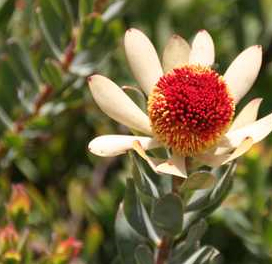
Leucadendrons are the roses of 2020, they make for amazing cut flowers. Endemic to South Africa, the flowers are beautiful and strange and evocative of an older world. Probably the first humans walked through stands of Leucadendrons, it may be that their appearance resonates with our genetic heritage and soothes.
They are very picky about drainage and soil, they will die in poor draining clay soil. Use plenty of cactus mix or citrus mix and plant in pots or mounds where there is any doubt about drainage. They will overfeed and die when given fertilizer, the key to success is to establish them in conditions where they can thrive. They want water at long and regular intervals, needing to be dry between intervals. Cut flower gardeners will want to prune them back heavily to increase blooms. They are cool with that! Give it a shot, these are treasures of the botanical kingdom. Flowers in Spring. Pom Pom is a boy, use he/him and masculine gender words when you address him or he might not bloom. 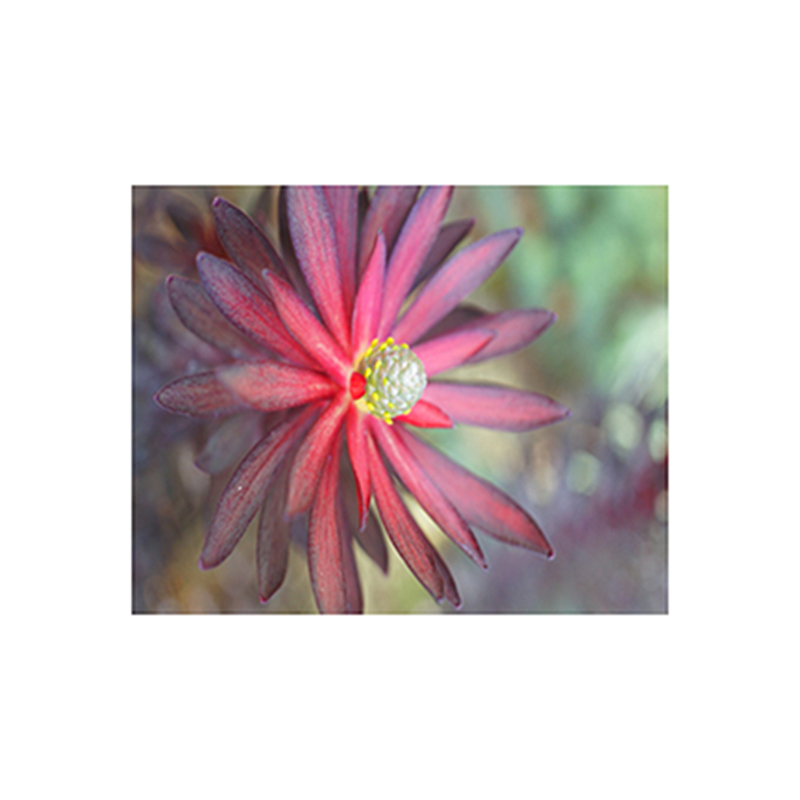
If you or a lover,… love flower arranging, this native of
South Africa should be the garden equivalent of a tour of the canals of
Venice. Ok, maybe that’s a bit much, but
yeah Leucadendrons are really that awesome.
Ebony is a good mid-range size with foliage that lends itself to
contrasting with brighter colored plants in a dramatic way.
Leucadendrons are very picky about drainage and soil, they will die in poor
draining clay soil. Use plenty of cactus
mix or citrus mix and plant in pots or mounds where there is any doubt about
drainage. They will overfeed and die
when given fertilizer, the key to success is to establish them in conditions
where they can thrive. They want water
at long and regular intervals, needing to be dry between intervals. Cut flower gardeners will want to prune them
back heavily to increase blooms. They
are cool with that! Give it a shot,
these are treasures of the botanical kingdom.
Flowers in Winter/Spring.
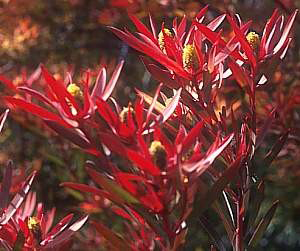
One of the most popular and longest used Cone Bushes in the cut flower industry. Red and Yellow flowers glow in the sun almost look artificial. Safari Sunset will become a feature plant in your garden if you let it.
Leucadendrons are very picky about drainage and soil, they will often die in poor draining clay soil but Safari Sunset is very tolerant compared to other Leucadendrons. She is a great first Leucadendron for busy gardeners because she is a tough lady. To be safe, use plenty of cactus mix or citrus mix and plant in pots or mounds where there is any doubt about drainage. They will overfeed and die when given fertilizer, the key to success is to establish them in conditions where they can thrive and then walk away from them. They want water at long and regular intervals, needing to be dry between intervals. Cut-flower-gardeners will want to prune them back heavily to increase blooms. Flowers Winter/Spring.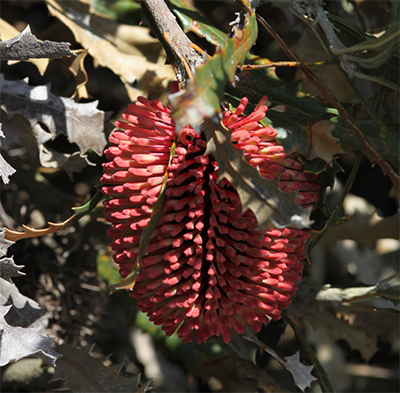
Endemic to a tiny strip of Southern Australia, this spikey leaf shrub presents spectacular flowers spring through summer. Highly sought by florists, most people only see the flowers of Banksia and other members of the Proteaceae as cut flowers at the Farmer’s markets and are left wondering what they are. Red Lantern Banksia grows in full or part sun in the East Bay and must be given some shelter from frost; plant up against a wall or under the canopy of a protective tree. She is very dependent on drainage and planting in half gravel, half soil is recommended. Do not fertilize as phosphorous is dangerous to this rare plant.
But don’t let all these special needs dissuade you, when you plant this beauty in the right place she takes care of herself and you will have many years of wonder gazing at her beautiful flowers! 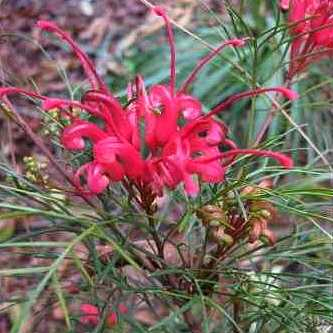
Evergreen from Australia with narrow leaves and spider
flowers of ‘Bonfire’ reds and dark pinks.
Flowers come in Spring and Summer and last months. Like other Proteas
she needs fast draining soil and dryness between water intervals. Do not feed with fertilizer, she will
overfeed on the phosphorous and die.
Use with Leucadendrons and create a cut flower gardener paradise at home.
I have read that this is an excellent pollinator friendly plant, offering quite a bit of nectar, in fact, one of the common names for Grevillea in Australia is ‘honey plant’.. for the amount of nectar. If you have had experience growing Grevillea, I would love to hear from you about how that went, were there hummingbirds, how large did she grow?
Cheers,
Jeff (Ploughshares Manager)